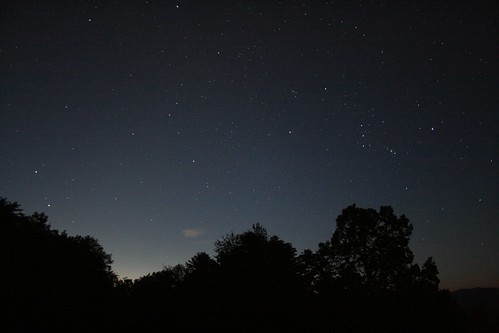
This shot was taken at 5:47 AM -- 30 minutes after "astronomical twilight," five minutes before "nautical twilight," and 65 minutes before sunrise -- and it clearly shows the early morning light in the eastern sky, along with Orion and many other stars. This was a 10-second exposure at 1600 ISO. (Larger view here.)
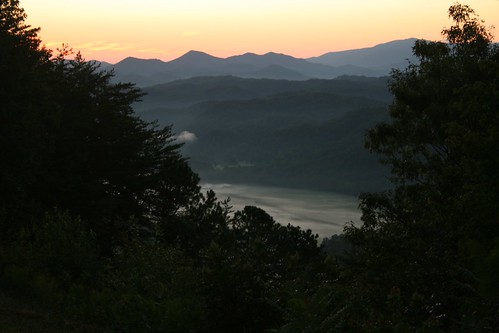
Dawn over the foggy Smokies, 15 minutes before sunrise. (Larger view here.) I deliberately overexposed the early sunlight in order to showcase the fog in the valley. Here's a similar shot after sunrise. And here's an earlier photo with the sunlight more properly exposed.
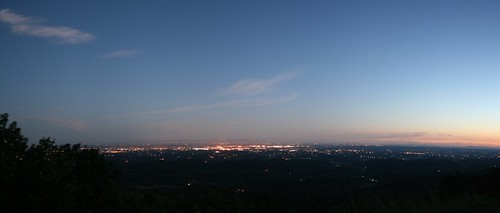
A panoramic view of Maryville, Knoxville, and the northern Tennessee mountains in the distance, taken 40 minutes before sunrise. This shot was actually stitched together from multiple photos. (Larger version; even larger version.)
Pretty as they are, those morning shots were incidental to my main goal of viewing -- and photographing -- some meteors! And I succeeded in that, too. Here's a zoomed-in, digitally enhanced version of my best meteor shot, which also includes an unidentified satellite:

The original is here. A more significantly enhanced version -- with lots of detail, but lots of noise -- is here.
The meteor is the diagonal line. The horizontal line at upper left is a passing satellite, which I didn't notice with my naked eye when I took the photo. It's not on Heavens-Above's list, so I'm guessing maybe it's a secret military satellite or some such thing. Cool!
Here's another meteor shot (enhanced version), taken a few seconds earlier, which also shows the same satellite. Believe it or not, these two photos were the only meteor pictures I captured all night -- and they were taken consecutively, within 30 seconds of each other!
Meanwhile, speaking of satellites, the first "meteor"-like object that I photographed yesterday morning was actually an Iridium flare of -1 magnitude, caused by Iridium 31:
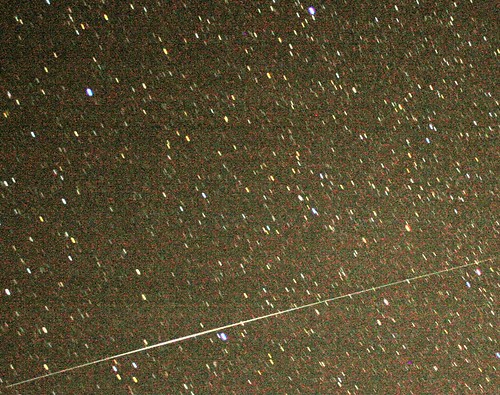
Again, that's digitally enhanced; hence the noise. The original is here.
The constellation that the satellite is passing through is Pegasus. The three clearly distinguishable bright white stars are, from bottom to top, Markab (the one the flare almost intersects with), Algenib, and Sirrah. The photo is a 68-second exposure, which explains the star trails.
One last photo is worth mentioning and showcasing here. Take a look at this picture, and tell me what (aside from a passing airplane at right) you think it shows:
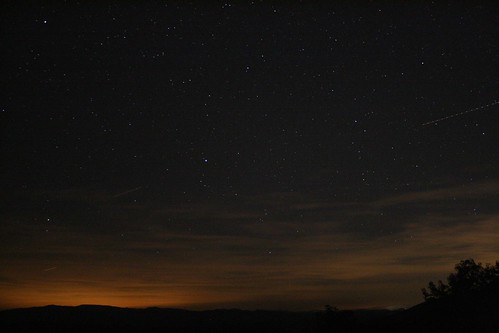
If you said "the dawn's early light," your guess is plausible, but wrong. This 20-second exposure, 1600 ISO shot was taken at 4:49 AM, long before the earliest morning light began to appear (astronomical twilight was at 5:17, sunrise at 6:52). And anyway, it's looking south-southwest, not east. Moreover, this light was visible all night long, and never got noticeably brighter or dimmer.
So, what is it? Well, unless there's a massive fire in the Smoky Mountains (and if there was, I'd think I would have heard about it on the news), it must be a city "light dome." But the question is, which one?
The answer, I believe, is that it's actually two light domes. The more diffuse, less intensely orange area at right, which is off to the southwest, is the light dome of Chattanooga, roughly 85 miles away. Meanwhile, the more intense, distant light dome to the left is -- I believe -- the light dome of Atlanta, some 130 miles away!
I almost can't believe that's right, but it must be, since there's a whole lot of nothing, city-wise, between the Foothills Parkway and Atlanta. Looking almost due south, across the Smokies, the only possible major source of city light is distant Atlanta. I had no idea light pollution could reach so far afield, but apparently it can!
Anyway... there are lots more photos of my wee-hours outing on the Flickr set. All the stargazing photos are on Page 1; all the sunrise photos are on Page 2. Enjoy!
